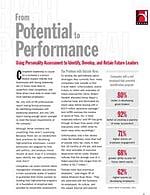 Strong leadership is a crucial ingredient for a successful company. With highly qualified people at the top, the entire organization is more likely to outperform the competition and hold on to their most talented employees. Yet, many organizations lack a tried-and-true method for identifying and developing those employees who show leadership potential.
Strong leadership is a crucial ingredient for a successful company. With highly qualified people at the top, the entire organization is more likely to outperform the competition and hold on to their most talented employees. Yet, many organizations lack a tried-and-true method for identifying and developing those employees who show leadership potential.
Current processes for identifying high-potential internal talent are often marred by bias and politics and rely on past performance as the main indicator of future performance. Such strategies reward bold, attention-grabbing behaviors that may be attractive in junior employees but become counterproductive at the upper levels.
As several recent high-profile stories suggest, companies don’t have much luck when hiring external C-level candidates either. Studies show that more than half of outside hires fail, many within the first 18 months on the job. As they are unfamiliar with the business, employees, culture, and unique challenges, it is no wonder why many external hires struggle to find success.
However, when hiring managers use the empirical data provided by personality assessment, rather than gut reactions influenced by politics or initial reactions in interviews, they can develop high-potential programs that ensure a stable of promising leaders. By using assessments, managers gain key insight into their high-potential employees in the following areas:
- Bright-side personality – the everyday personality that determines leadership style, judgment, and ability to get along and get ahead
- Dark-side personality – also called derailment personality, this consists of characteristics that under stress or boredom can become debilitating career derailers
- Values – the drivers, beliefs and interests that determine what candidates are willing to work for and in what type of job, position, and organizational culture they are likely to feel most satisfied
- Cognitive ability – a measure of candidates’ ability to think tactically and strategically
When personality assessments are at the center of a high-potential program, organizations have an empirical basis for identifying, selecting, and developing the next generation of leaders.
To learn more about how personality assessment can be used to identify, develop, and retain future leaders, download our complimentary white paper, From Potential to Performance.


 In his recent Wall Street Journal article, “
In his recent Wall Street Journal article, “ Like many people, my coworker is afraid of flying. We encourage him to take sleeping pills and try to distract him with entertaining stories during takeoff, but despite our best efforts, he usually remains anxious throughout the flight.
Like many people, my coworker is afraid of flying. We encourage him to take sleeping pills and try to distract him with entertaining stories during takeoff, but despite our best efforts, he usually remains anxious throughout the flight.